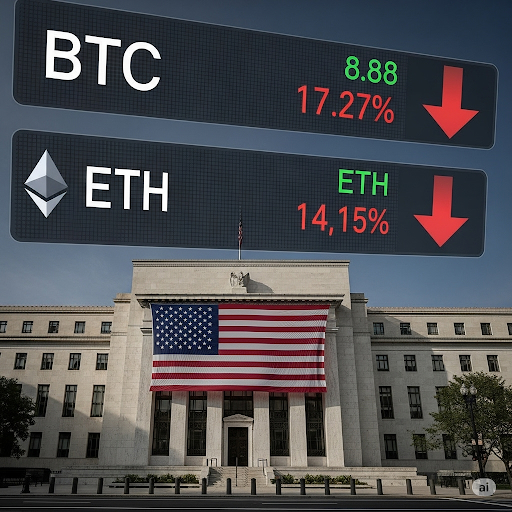Crypto Markets Struggle Amid Weak U.S. Jobs Data and Tariff Tensions

Crypto Markets Struggle Amid Weak U.S. Jobs Data and Tariff Tensions
The global crypto market faced renewed volatility today as macroeconomic headwinds from the United States intensified. Weak employment figures, rising trade protectionism, and uncertainty around future monetary policy have placed fresh pressure on Bitcoin, Ethereum, and broader Web3 asset classes.
Economic Indicators Cloud Market Sentiment
Recent U.S. labor data revealed significantly weaker-than-expected job growth for the month, igniting fears of a cooling labor market. The increase in unemployment—combined with downward revisions to prior months’ figures—raised concerns that the economic recovery may be losing steam.
Markets were quick to react. Bitcoin dipped below key technical support levels during the early hours of trading before stabilizing later in the day. Ethereum mirrored the same trajectory, showing sensitivity to both rate speculation and institutional flows. The sell-off was most acute in altcoins and DeFi tokens, which tend to be more vulnerable to shifts in risk appetite.
The softer jobs data prompted speculation that the Federal Reserve may soon consider rate adjustments. While no immediate pivot was announced, traders are now pricing in higher probabilities of a policy shift by Q4, which could reignite interest in crypto as a hedge against fiat debasement and monetary easing.
Trade Tensions Resurface
At the same time, geopolitical tensions around U.S. trade policy are once again in the spotlight. New tariff measures introduced against key trading partners—including Canada, Mexico, and portions of the EU—have triggered concerns over supply chain constraints, increased import costs, and inflationary pressure.
Historically, such policy moves have added uncertainty to both traditional and digital markets. For crypto, these measures often result in mixed outcomes. On one hand, economic instability tends to drive interest in decentralized alternatives. On the other, trade volatility and risk aversion can cause institutional capital to temporarily exit speculative assets like cryptocurrencies.
Some market observers view this moment as a turning point—where crypto begins to decouple from broader macro cycles. However, with high correlation between Bitcoin and tech indices still observed, short-term effects of economic stress continue to ripple through the ecosystem.
Institutional Activity Cools But Doesn’t Disappear
The broader sentiment across crypto institutions remains cautious but not bearish. While fund inflows have slowed, there’s no significant evidence of mass exits from the space. In fact, several custodial and infrastructure firms reported increased wallet activations and onboarding interest from mid-size funds seeking entry at lower valuations.
This divergence—between short-term price movements and long-term infrastructure adoption—may signal growing market maturity. Analysts suggest that smart money is using macro-driven dips as strategic entry points, particularly into tokens with utility in decentralized identity, on-chain data, and AI-powered dApps.
Regulatory Expectations Shift Toward Structure
Meanwhile, in Washington, the conversation around digital assets is changing in tone. New proposals aimed at regulating stablecoins, categorizing digital commodities, and formalizing cross-border asset flows are gaining traction. While regulatory clarity is still in flux, the direction is becoming more defined—prompting developers and investors to position themselves for long-term integration with legacy finance systems.
There’s also growing speculation around potential changes in leadership at major regulatory agencies, which could significantly affect the pace and structure of crypto policy over the next year. For builders in the Web3 space, this means the next few months will be pivotal in aligning product design with upcoming compliance frameworks.
Community Sentiment and Developer Focus
Despite macroeconomic turbulence, the core of the Web3 community remains resilient. Developer activity on public blockchains has remained steady, with notable progress in Layer 2 scaling, decentralized identity protocols, and tokenized real-world asset infrastructure.
Communities around Ethereum, Solana, and newer Layer 1s continue to test, fork, and iterate rapidly. DAO participation is also increasing, suggesting that user governance is not only surviving, but evolving amid external stress.
For many in the space, the current market conditions are not a crisis—but a recalibration. A time to consolidate, build, and prepare for the next wave of growth when global macro conditions stabilize.
Conclusion
Crypto markets are once again at the crossroads of global economic shifts. Weak job data, rising tariffs, and monetary uncertainty have cast a shadow over risk assets. But for the maturing Web3 ecosystem, these moments are becoming less about panic and more about positioning.
While price volatility may continue in the short term, the underlying narrative is one of adaptation and endurance. In this environment, projects with real-world utility, governance transparency, and economic sustainability are likely to emerge stronger—and ready for the next phase of global digital transformation.
Comments (2)
Web3 Reader
June 16, 2025
Very informative article! I agree that Bitcoin ETFs are a game-changer.
Crypto Enthusiast
June 16, 2025
I wonder how regulations will affect adoption in developing countries.